- Home
- Isaac Asimov
Asimov's Future History Volume 1
Asimov's Future History Volume 1 Read online
Asimov’s Future History
Volume I
All stories copyright Isaac Asimov and the Estate of Isaac Asimov, unless otherwise noted below.
All other stories copyright by the respective authors listed below.
To the Continuing End of Eternity-by Greg Toland, January, 2000
A Boy’s Best Friend-First published in Boys’ Life magazine Mar, 1975
Robbie-First published in I, Robot, 1950. A slightly different (the original) version appears in Super Science Stories, September, 1940 as Strange Playfellow
Robot AL-76 Goes Astray-First published in Amazing Stories, Feb, 1942
Insert Knob A in Hold B-First published in The Magazine of Fantasy and Science Fiction, December, 1957
Runaround-First published in Astounding Science-Fiction, March, 1942
Reason-First published in Astounding Science-Fiction, April, 1941
Catch That Rabbit-First published in Astounding Science Fiction, February, 1944
Safety First-by Johnny Pez, August, 2001
Liar!-First published in Astounding Science-Fiction, May, 1941
Satisfaction Guaranteed-First published in Amazing Stories, April, 1951
Balance-By Mike Resnick. First published in Foundation’s Friends: Stories in Honor of Isaac Asimov, September, 1989
Lenny-First published in Infinity Science Fiction, January, 1958
Blot-By Hal Clement. First published in Foundation’s Friends: Stories in Honor of Isaac Asimov, September, 1989
Little Lost Robot-First published in Astounding Science Fiction, March, 1947
Escape!-First published in Astounding Science Fiction, August, 1945
Cal-First published in Gold: The Final Science Fiction Collection, March, 1995
Evidence-First published in Astounding Science Fiction, September, 1946
PAPPI-By Sheila Finch. First published in Foundation’s Friends: Stories in Honor of Isaac Asimov, September, 1989
Risk-Fist published in Astounding Science Fiction, May, 1955
Galley Slave-Fist published in Galaxy Science Fiction, December, 1957
First Law-First published in Fantastic Universe, October, 1956
Plato’s Cave-By Poul Anderson. First published in Foundation’s Friends: Stories in Honor of Isaac Asimov, September, 1989
The Martian Dilemma-By David Pinkston. May, 2001
Non-Compliance-By Greg Toland. July, 2001
The Evitable Conflict-First published in Astounding Science Fiction, June, 1950
Robot Dreams-First published in Robot Dreams, November, 1986
I, Robot-First published by Gnome Press, 1950
The Eternal Woman-By Wendell Urth, June, 2001
Feminine Intuition-First published in The Magazine of Fantasy and Science Fiction, October, 1969
The Fourth Law of Robotics-by Harry Harrison. First published in Foundation’s Friends: Stories in Honor of Isaac Asimov, September, 1989
Christmas Without Rodney-First published in Isaac Asimov’s Science Fiction Magazine, Mid-December, 1988
Kid Brother-First published in Isaac Asimov’s Science Fiction Magazine, Mid-December, 1990
This ePub edition v1.0 by Dead^Man March, 2011
Mobi and LIT editions published simultaneously.
Layout and design by DeadMan
Cover art: “Yacht” by guitfiddle of DeviantArt
Future History inlay “Summer days” by Talros of DeviantArt
Cover design by Dead^Man
Chronology of events in Isaac Asimov’s positronic robot and Foundation stories, compiled by Johnny Pez
Table of Contents
Copyright
Introduction
1982 AD To the Continuing End of Eternity
1995 AD A Boy’s Best Friend
1998 AD Robbie
2006 AD Robot AL-76 Goes Astray
2010 AD Insert Knob A in Hold B
2015 AD Runaround
2015 AD Reason
2016 AD Catch That Rabbit
2020 AD Safety First
2021 AD Liar!
2023 AD Satisfaction Guaranteed
2024 AD Balance
2025 AD Lenny
2026 AD Blot
2029 AD Little Lost Robot
2030 AD Escape!
2031 AD Cal
2032 AD Evidence
2032 AD PAPPI
2033 AD Risk
2034 AD Galley Slave
2035 AD First Law
2036 AD Plato’s Cave
2044 AD The Martian Dilemma
2051 AD Non-Compliance
2052 AD The Evitable Conflict
2055 AD Robot Dreams
2058 AD I, Robot
2060 AD The Eternal Woman
2063 AD Feminine Intuition
2065 AD The Fourth Law of Robotics
2090 AD Christmas Without Rodney
2120 AD Kid Brother
Sources of dates
Introduction
The Fan Edit
2011 A.D.
SO HERE I sit, around 30 years after being introduced to The Foundation stories by one of my older brothers when I was around 11 years old. Star Wars had been out for 2 years, and I was yearning for something that could match the magic that that movie brought to me at that age. Yes, I started reading at a much earlier age-I loved mysteries and had read every Nancy Drew and Hardy Boys story I could get my hands on. I couldn’t quite get into reading fantasy at the time, having read maybe one chapter of Lord of the Rings before never going back to it–I still have yet to finish that chapter. My brother tells me something along the lines of, “Shut up and read these (Foundation books), they are good!”. Well, how could I doubt my big brother who drove such a cool muraled van? Since then, Asimov has been my favorite author and I have collected just about every real book of his I could find. His universe had all that I have enjoyed reading and writing about all these years. There are a great many other books in my library, of course, but the Asimov Collection is the heart of all of it, It consists of about 400 books, many having 3 or 4 copies from collections I have purchased over the years.
Anyway, I am one who likes to read everything in order. It has come time again to read the entire Future History as laid out by Dr. Asimov and the others who have contributed to the series over the years. This was a project I have had in mind for some years now, and it is something that you folks will never see assembled by any company (for more reasons than one). Several of the fan fiction ones I have not include as they appear to be incomplete, or just don’t fit the theme of the universe and may be better plugged into some other. I did consider adding Donald Kingsbury’s Psychohistorical Crisis, while although interesting, doesn’t belong here.
Thanks go out to Johnny Pez and his Insanely Complete Fiction List, which I used for all the dates in these volumes. Some books are missing from his list now since it hasn’t been updated since 2001, and some of the dates had to be adjusted slightly; Aurora, Have Robot, Will Travel (these first two not having been released since Mr. Pez last updated his list) and Robots and Empire. There is an updated list provided at the end of Aurora by Attila Torkos. I have decided to stick with the Pez edition since he lists the references to dates from within the books and gives good explanations to the not so obvious ones. I will list both versions in the last volume.
I have taken some liberties in reassembling all the books into these volumes. I, Robot (in this volume) being chopped up to exclude the stories that are inserted into the interviews, leaving only a few lines of the short story they are referring too to lead into the next segment of interviews. Some others, I have removed the title of the book and left only the short stories that would have made it up, mostly th
e early Foundation books.
The cover layout and design is my own. My skills with photoshop are basic at best. Most cover art is taken from the fine folks at the Deviant Art site. Each artist is credited in the copyright section. If anyone wishes to create really nice covers, you can email them to me at the email given below. I did want to create more themed covers based on the contents in each volume, but there is just to much art out there to keep track of.
As with all my conversions, the formatting is left simple so as to work on as many ereading devices as possible, with out you having to muck about with it (But I’m sure someone will anyway, can’t please them all). I don’t like hyperlinks in eBooks (clickable lines in the TOC section), but have added them to this collection to make some folks happy; The rest of us will just have to endure the difficult and painful process of scrolling past them. Those that use a reader that views ePub formats will see more links in the ePub Table of Contents listings than there are hyperlinks listed in the TOC for each volume. There will be some errors through-out the volumes, like broken sentences, screwy punctuation and what-not. I have spent a lot of time fixing and tweaking the text. Even the ‘retail’ ones I bought, which are not much better than some of the scans kicking around. (Authors should be making more of a stink about these horribly created retail ebooks!)
By now, your asking, who the hell is this guy? I’m the Dead Man., since 1987. I can thank Glen Cook for that handle – another great author, you should really read his books too. (I don’t think I’m as ugly as the Dead Man in his books though! Although, I’m about as lively sometimes after a long day at work.)
I hope some of the Asimov fans will enjoy how this Fan Edit will all be put together in the end. Feel free to send an email to dmebooks “at” live.ca.
Enjoy,
ÐM
The Three Laws of Robotics
1. A robot may not injure a human being or, through inaction, allow a human being to come to harm.
2. A robot must obey the orders given it by human beings except where that would conflict with the First Law.
3. A robot must protect its own existence as long as such protection does not conflict with the First or Second Law.
To the Continuing End of Eternity
1982 A.D.
“… … … and so ladies and gentlemen Consolidated Computers are proud to present to you the first positronic brain!” David Williams stepped back from the podium and with a feeling of embarrassment jabbed at the button to draw back the curtains to expose his and countless other experimenter’s life work.
The muted applause died down and David could sense the anti-climax amongst his audience. It was exactly the same response his bosses had given three weeks earlier. Why should the press feel any different from the so called experts who had funded it, admittedly not understanding what they were supporting. He turned to look at the brain, all eight ounces of it, enclosed in the plexpous dome with twinkling lights from the computer controlled display system. He wished that they had not agreed to the demands of the marketing men to make the presentation more glossy.
The positronic brain sat there linked to a number of external devices and controls. To the left was the speech interpretation unit. God, he thought. Doesn’t it look dreadful. He wished that they had the extra two months that they had requested, before it was presented to the public.
Mind you the vision sub-system did not look much better, the whole thing looked as if it had been thrown together in a matter of weeks, which unfortunately was what had happened when the planned design proved to be totally unsuitable.
Questions started to come from the floor to derail his train of thought.
“Doctor, why is this such a quantum leap in computer technology?” That was the planted question that he hoped would be asked first. “Well in order to answer that I think a little history is in order. You are all aware of the development of the computer from the early electro-mechanical calculating machines, through the valve to the micro-processor …?”
He trailed off looking around the room at the nodding heads. “Good. That will save us some time. Now what are the disadvantages of this form of the computer.”
He started to tick off the points on his fingers. “One, it requires a relatively large power supply both physically and in energy terms. Two, it can only operate in a very restricted manner defined exactly by its programming. Three, it …”
Before he could continue the interruption he was dreading came in from Alton Ferdinand, “Are you therefore saying that this computer,” he seemed to make the word an insult, “operates the way it wants to and therefore cannot be controlled?”
“No, that is not what I’m trying to say. If Mr. Ferdinand would listen to the facts and not try to put his prejudices over to this audience.......” began David.
Too late, Alton was in full flow. “These machines are depriving man-kind of his humanity. They are abominations that have no place in our society and here we even have one of their creators telling us that they are uncontrolled.”
David saw his opportunity to respond and leapt at the chance. “I’m glad I have the opportunity to address that issue for my colleague from the Divine College.” He hoped that the comment would be taken with the right amount of sarcasm.
“A long time ago this problem was anticipated by a science fiction writer called Isaac Asimov, and he devised the Three Laws of Robotics and I would like to quote them to you from one of his books.”
He reached into his pocket and pulled out a battered copy of I, Robot. This was a deliberate ploy. He hoped that the production of an actual antiquarian book would carry more weight with the audience than using the book films and medias that replaced them.
He started to read.
“First Law: A Robot may not injure a human being, or, through inaction, allow a human being to come to harm.
“Second Law: A Robot must obey the orders given it by any human being except where such orders would conflict with the First Law.
“Third Law: A Robot must protect its own existence as long as such protection does not conflict with the First or Second Laws.”
He paused dramatically at the end of the Laws, somehow they always had a capital letter in his mind. “These Laws have been incorporated within the positronic brain and all actions controlled by the brain are constrained to operate within these bounds. They are fundamentally safer and more controlled than you or I or any other human could ever be. You can have nothing to fear from them.”
He could see it was a losing battle and the press conference went rapidly downhill from that point onwards. He waited with trepidation for the telecast newspaper coverage of the announcement. He turned rapidly to the centre pages and there in practically each and every one was the headlines he had been dreading.
‘Uncontrolled Computer Created … Antediluvian Lunatic Science Fiction Writer devised Control Program’.
He turned away in disgust.
“Well what did you expect,” said Thor Simpson. “You walked straight into it with that crazy comment about Asimov!”
“But, it’s the truth. That is where the basics were taken from to incorporate into the Posian Rule Generator, and if we hadn’t done that …”
“So what,” interrupted Thor. “You know that, I know that, and so do many of the other developers but to spout that nonsense in front of a hard nosed critic like Ferdinand was suicidal.”
David wondered where could they go from here. All of the budgets were spent, no he corrected himself-overspent, and the company would not be prepared to fund any more research and development. Probably his best bet was to get out and find another company who were working in a similar field of research and development.
It was a very long and miserable journey home that evening. His wife Sue knew the moment he walked through the door that the presentation had not gone well. She waited quietly for the explosion of pent-up frustration that she knew would come.
“How small-minded and short-sighted can an organisat
ion be? We are standing at the edge of a new technology which will become a society shaking …”
He went on for a few minutes during which Sue was able to do little more than nod. It was a diatribe she had heard many times before.
She eventually asked, “So what are you going to do about it?”
“I don’t think it will be down to me in the long run,” he replied. “There’s a meeting first thing tomorrow in Wilson’s office and I think the project will be closed and we’ll either be redundant or reassigned to other activities”.
“What’s likely for us?”
She thought of the monthly bills. They weren’t badly off but of course they needed the monthly pay check.
“Oh, I don’t think I’ll have any problems,” he said with what he hoped sounded like confidence. “I’ve been there sufficient time that I won’t be classed as a ‘newbie’ but also there’s people like Adams who they’ll let go first.”
He knew though that if a few people had to go he would be high on the list.
He had never got on with Wilson, the woman just had no idea of how to run a project of this magnitude, and did not understand any of the concepts that they were working towards. She was out of her depth.
The conversation went on long into the night and even after going to bed sleep did not come easily.
The next day started with a sharp frost but by the time he was driving down the freeway it was turning into a typical Washington State Spring day. The sun was low on the horizon but very bright as he made his way to the office. As he pulled into his parking space he saw most of the team were already in. Georgina Jones was just getting out of her car and she waited for him.
“Where’s the black armband?” she asked with an attempt at levity. She knew that she was likely to be first to go as she was the youngest and last to join the team.
“I know,” was his laconic reply. Any attempt of optimism had evaporated on the drive in. He had decided that the project was to be curtailed and he was now totally prepared for the meeting. He decide to go quietly. Ranting and raving would only give Wilson satisfaction and he refused to give her that pleasure.

 The Return of the Black Widowers
The Return of the Black Widowers The Stars, Like Dust
The Stars, Like Dust Foundation
Foundation David Starr Space Ranger
David Starr Space Ranger I, Robot
I, Robot Puzzles of the Black Widowers
Puzzles of the Black Widowers Casebook of the Black Widowers
Casebook of the Black Widowers The Ugly Little Boy
The Ugly Little Boy Azazel
Azazel Pebble in the Sky
Pebble in the Sky Foundation and Empire
Foundation and Empire The Complete Robot
The Complete Robot Fantastic Voyage
Fantastic Voyage Foundation and Earth
Foundation and Earth The Naked Sun
The Naked Sun The Currents of Space
The Currents of Space Foundation's Edge
Foundation's Edge The Robots of Dawn
The Robots of Dawn Nightfall
Nightfall The Caves of Steel
The Caves of Steel Prelude to Foundation
Prelude to Foundation Nemesis
Nemesis Robot Dreams
Robot Dreams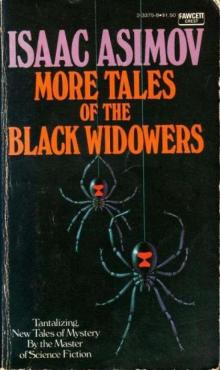 More Tales of the Black Widowers
More Tales of the Black Widowers The Complete Stories
The Complete Stories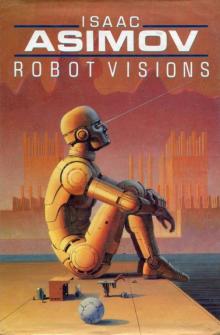 Robot Visions
Robot Visions Lucky Starr And The Moons of Jupiter
Lucky Starr And The Moons of Jupiter Lucky Starr and the Big Sun of Mercury
Lucky Starr and the Big Sun of Mercury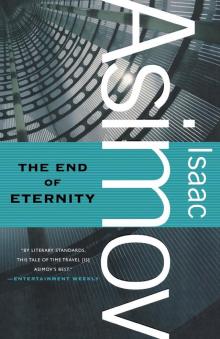 The End of Eternity
The End of Eternity The Bicentennial Man and Other Stories
The Bicentennial Man and Other Stories Lucky Starr And The Rings Of Saturn
Lucky Starr And The Rings Of Saturn Buy Jupiter and Other Stories
Buy Jupiter and Other Stories Forward the Foundation
Forward the Foundation Lucky Starr and the Oceans of Venus
Lucky Starr and the Oceans of Venus The Positronic Man
The Positronic Man The Portable Star
The Portable Star Asimovs Mysteries
Asimovs Mysteries Earth Is Room Enough
Earth Is Room Enough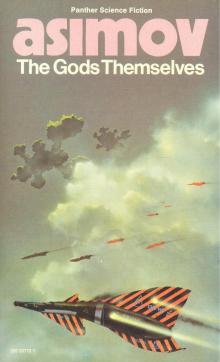 The Gods Themselves
The Gods Themselves Youth
Youth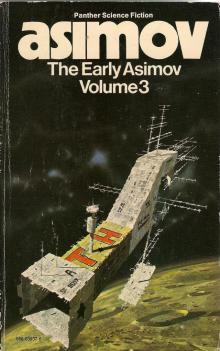 The Early Asimov Volume 3
The Early Asimov Volume 3 The Winds of Change and Other Stories
The Winds of Change and Other Stories Of Time, Space, and Other Things
Of Time, Space, and Other Things Nine Tomorrows
Nine Tomorrows Time Warps
Time Warps Robots and Empire
Robots and Empire Young Star Travelers
Young Star Travelers Fantastic Voyage II: Destination Brain
Fantastic Voyage II: Destination Brain Second Foundation
Second Foundation The Rest of the Robots
The Rest of the Robots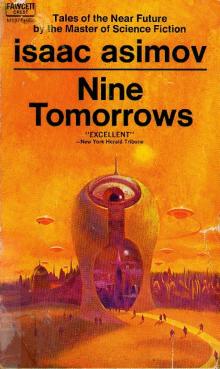 NINE TOMORROWS Tales of the Near Future
NINE TOMORROWS Tales of the Near Future Daneel Olivaw 1 - The Caves of Steel
Daneel Olivaw 1 - The Caves of Steel THE BICENTENNIAL MAN
THE BICENTENNIAL MAN David Starr Space Ranger (lucky starr)
David Starr Space Ranger (lucky starr)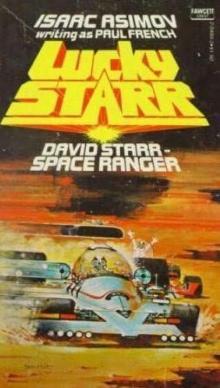 David Starr Space Ranger (ls)
David Starr Space Ranger (ls) Lucky Starr And The Big Sun Of Mercury ls-4
Lucky Starr And The Big Sun Of Mercury ls-4 Pebble In The Sky te-1
Pebble In The Sky te-1 Asimov’s Future History Volume 9
Asimov’s Future History Volume 9 Gold: The Final Science Fiction Collection
Gold: The Final Science Fiction Collection Foundation and Earth f-7
Foundation and Earth f-7 Asimov's New Guide to Science
Asimov's New Guide to Science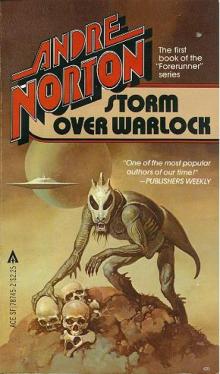 STORM OVER WARLOCK
STORM OVER WARLOCK Stars, Like Dust
Stars, Like Dust Norby The Mixed-Up Robot
Norby The Mixed-Up Robot Found!
Found! Asimov’s Future History Volume 11
Asimov’s Future History Volume 11 Second Foundation f-5
Second Foundation f-5 Asimov’s Future History Volume 15
Asimov’s Future History Volume 15 The Early Asimov. Volume 1
The Early Asimov. Volume 1 Secound Foundation
Secound Foundation Daneel Olivaw 3 - The Robots of Dawn
Daneel Olivaw 3 - The Robots of Dawn Asimov’s Future History Volume 6
Asimov’s Future History Volume 6 The Early Asimov. Volume 2
The Early Asimov. Volume 2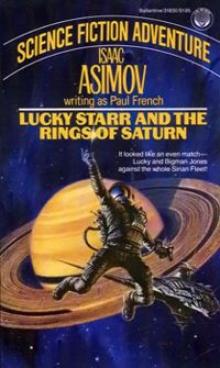 Lucky Starr And The Rings Of Saturn ls-6
Lucky Starr And The Rings Of Saturn ls-6 100 Malicious Little Mysteries
100 Malicious Little Mysteries Forward the Foundation f-2
Forward the Foundation f-2 I.Asimov: A Memoir
I.Asimov: A Memoir Foundation's Edge f-6
Foundation's Edge f-6 Lucky Starr and the Pirates of the Asteroids ls-2
Lucky Starr and the Pirates of the Asteroids ls-2 Robot City 1 & 2
Robot City 1 & 2 The Fourth Science Fiction Megapack
The Fourth Science Fiction Megapack Asimov’s Future History Volume 16
Asimov’s Future History Volume 16 The Dim Rumble
The Dim Rumble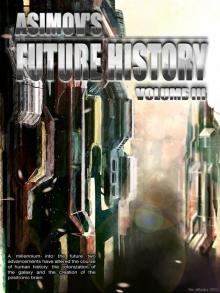 Asimov's Future History Volume 3
Asimov's Future History Volume 3 The Currents Of Space te-3
The Currents Of Space te-3 Asimov’s Guide To Shakespear. Volume 1
Asimov’s Guide To Shakespear. Volume 1 Asimov’s Future History Volume 13
Asimov’s Future History Volume 13 Asimov’s Future History Volume 12
Asimov’s Future History Volume 12 The Secret Sense
The Secret Sense Of Time and Space and Other Things
Of Time and Space and Other Things Norby tnc-2
Norby tnc-2 Norby The Mixed-Up Robot tnc-1
Norby The Mixed-Up Robot tnc-1 Misbegotten Missionary
Misbegotten Missionary Asimov’s Future History Volume 19
Asimov’s Future History Volume 19 Fantastic Voyage II: Destination Brain fv-2
Fantastic Voyage II: Destination Brain fv-2 Asimov’s Future History Volume 10
Asimov’s Future History Volume 10 Asimov's Future History Volume 2
Asimov's Future History Volume 2 Feeling of Power
Feeling of Power In the Beginning
In the Beginning The Caves of Steel trs-1
The Caves of Steel trs-1 Asimov's Future History Vol 2
Asimov's Future History Vol 2 Caliban c-1
Caliban c-1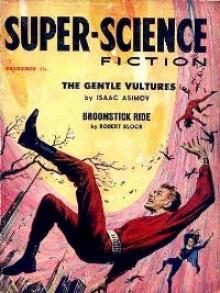 The Gentle Vultures
The Gentle Vultures Utopia c-3
Utopia c-3 Prelude to Foundation f-1
Prelude to Foundation f-1 Short Stories Vol.1
Short Stories Vol.1 Asimov’s Future History Volume 8
Asimov’s Future History Volume 8 Daneel Olivaw 4 - Robots and Empire
Daneel Olivaw 4 - Robots and Empire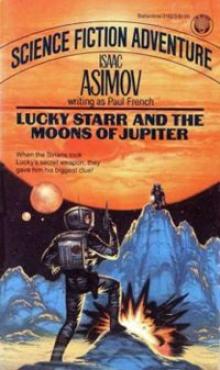 Lucky Starr The And The Moons of Jupiter ls-5
Lucky Starr The And The Moons of Jupiter ls-5 Gold
Gold Asimov’s Future History Volume 4
Asimov’s Future History Volume 4 Foundation and Empire f-4
Foundation and Empire f-4 Potential
Potential Asimov’s Future History Volume 14
Asimov’s Future History Volume 14 Asimov’s Future History Volume 7
Asimov’s Future History Volume 7 Daneel Olivaw 2 - The Naked Sun
Daneel Olivaw 2 - The Naked Sun Lucky Starr and the Pirates of the Asteroids
Lucky Starr and the Pirates of the Asteroids Foundation f-3
Foundation f-3 All the Troubles of the World
All the Troubles of the World Cleon the Emperor
Cleon the Emperor Asimov's Future History Volume 5
Asimov's Future History Volume 5 Asimov’s Future History Volume 20
Asimov’s Future History Volume 20 Robots and Empire trs-4
Robots and Empire trs-4 Profession
Profession It's Been a Good Life
It's Been a Good Life The Robots of Dawn trs-3
The Robots of Dawn trs-3 Lucky Starr And The Oceanf Of Venus ls-3
Lucky Starr And The Oceanf Of Venus ls-3 The Naked Sun trs-2
The Naked Sun trs-2 Asimov's Future History Volume 1
Asimov's Future History Volume 1